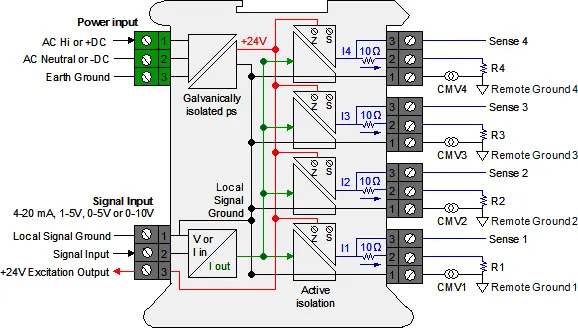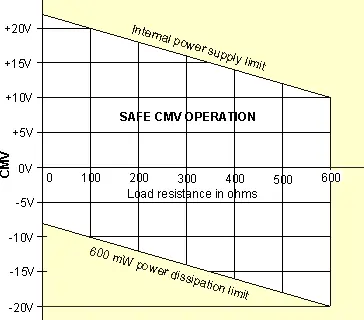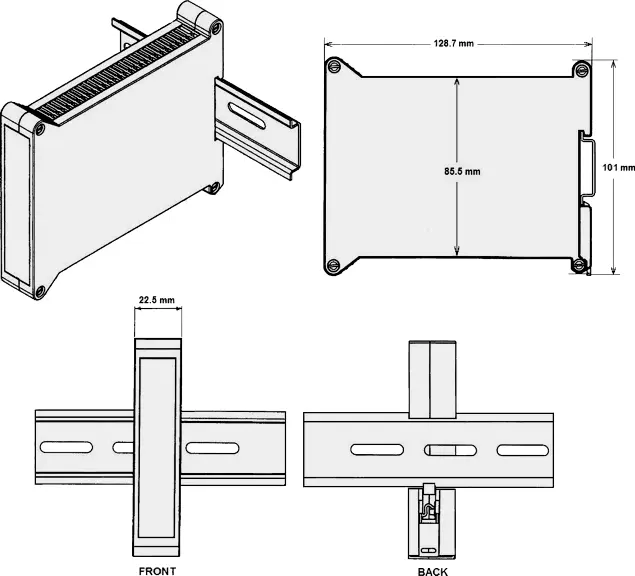
Features
- Accepts a 4-20 mA, 1-5V, 0-5V or 0-10V input signal
- Drives four (4) independent 4-20 mA outputs proportional to input
- Signal input and outputs can share a common ground
- Remote grounds can differ by up to ±10V from local signal ground
- Opening any output loop does not affect other loops
- ±10 zero and span fine adjustments for each output loop
- Loop current test point for each output, where 200 mV = 20 mA
- Indicator LED for each connected output
- Powered by 85-264 Vac or 90-300 Vdc (Model QLS-1)
- Powered by 10-48 Vdc or 12-32 Vac (Model QLS-2)
- Powers a 2- or 3-wire input transmitter at 24 Vdc at up to 30 mA
- 22.5 mm (0.9") wide case snaps to 35 mm DIN rail
- Weighs only 159 g (5.6 oz)
- Operating temperature from -40°C to 70°C (-40°F to 158°F)
Features of the LT DIN Rail Digital Transmitter for Quad Loop Splitter / Retransmitter
The LT DIN Rail Digital Transmitter accepts 4-20 mA, 1-5V, 0-5V, or 0-10V inputs and drives four independent 4-20 mA outputs with ±10V common mode isolation. It supports shared or ±10V differing grounds, with each loop featuring ±10% zero/span adjustments, a 200 mV = 20 mA test point, and an LED indicator. Powered by 85-264 Vac/90-300 Vdc (QLS-1) or 10-48 Vdc/12-32 Vac (QLS-2), it powers 2- or 3-wire transmitters at 24 Vdc up to 30 mA. Housed in a 22.5 mm case for 35 mm DIN rail, it weighs 159 g and operates from -40°C to 70°C, with CE, RoHS3, and ETL certifications. The LT Quad Loop Splitter solves series loop issues by providing four adjustable outputs from one input, ensuring unaffected loops if one fails. It includes LED diagnostics and test points, enhancing reliability and ease of use.
The QLS-1 and QLS-2 are factory-calibrated. For optimal accuracy, factory recalibration is recommended annually. All Laurel Electronics instruments undergo factory calibration using the industry-leading Fluke calibrators, which are recalibrated yearly and certified traceable to national standards, ensuring the highest level of precision and reliability.
Problems with Current Loop Loads in Series

| Common Practice: | A single 4-20 mA loop from a sensor is connector to a panel meter, a control valve, a recorder and a PLC in series. If the loop opens, all devices in the loop fail. |
- All devices in the loop cannot share a common ground, but must be electrically floating. This is often not possible.
- When any device in a loop is removed, fails, or if a wiring fault occurs, all other devices in the loop loose their 4-20 mA signal.
- The transmitter(signal conditioner) voltage compliance limit may be exceeded, since the voltage drops across loads in series are additive.
- The 4-20 mA signal to each load device cannot be individually adjusted for calibration purposes.
- There are not diagnostics for the current to each load.
The Laureate QLS Loop Splitter / Retransmitter Solution

| Improved Practice: | Four independent 4-20 mA loops with ±10V common mode isolation. If any of the output loops opens, only a single device is affected. The output loops can share a common ground. |
- Sources up to four (4) independently adjustable 4-20 mA outputs from a single input, which can be 4-20 mA, 1-5V, 0-5V or 0-10V, as selected by jumpers.
- If any device in an output loop is removed from a loop or fails, or if a wiring fault occurs in any loop, the other loops continue to operate properly.
- Signal input and outputs can share a common signal ground.
- Common mode volage of output loops is ±10V by means of active circuity so that remote grounds can vary by up to ±10V.
- Each loop only drives a single load, thus avoiding voltage compliance problems.
- ±10% of zero and span adjustment are provided for each output loop to allow for independent loop calibration.
- Diagnostics for each output loop are provided by a yellow LED lamp to indicate loop continuity and by a test point across a 10Ω series resistor, where 200 mV corresponds to 20 mA. The test point allows a multimeter to measure the loop current without breaking the loop.
- Power for the loop splitter can be high voltage 85-264 Vac or 90-300 Vdc (Model QLS-1) or low voltage 10-48 Vdc or 12-32 Vac (Model QLS-2). An excitation output is provided on the signal input side to drive a 2- or 3-wire transmitter at 24 Vdc up to 30 mA.
QLS Pinouts and Theory of Operation

Galvanic & Active Isolation: A single input current loop is split into four independent output loops I1, I2, I3 and I4 by four current generators. The input and output signals are galvanically isolated from power and earth grounds by up to 264 Vac. Active circuitry allows a common mode voltage up to ±10V between Local Signal Ground (on pins 1) and the Remote Grounds. Each common mode voltages, labeled CMV1 to CMV4 in the diagram, reflects the actual voltage difference between Local Signal Ground and the Remote Ground. Such differences can be caused by current flows in the factory.
Floating loads: Any output load R that is floating (not connected to Earth Ground or a Local Ground) can be connected between current output (Pin 1) and current return (Pin 2). Current return is internally tied to Signal Ground, which can be floating or be connected to Earth Ground.
Grounded loads: Any output load R can be connected to a Local Ground instead of current return. The Remote Grounds can each be different, but can only differ from Signal Ground by a safe common mode voltage CMV. Signal Ground should be tied to Earth Ground to minimize noise pickup.

Input-output isolation: If a load R is grounded to a Local Ground, the available common mode voltage CMV is limited on the positive side by the unit's internal power supply and on the negative side by the 600 mW power dissipation limit of an output transistor. The above diagram shows allowable CMV as a function of output load resistance R. For example, with a 250Ω load, CMV can range from -13V to +17V. With a 500Ω load, CMV can range from -18V to +12V. The unit will not work correctly if CMV limits are exceeded or the load resistance is greater than 600Ω.
| Signal Input & Excitation | ||||
|---|---|---|---|---|
| Signal Type | 4-20 mA, 1-5V, 0-5V, 0-10V (jumper selectable) | |||
| Input Resistance | 50Ω for 4-20 mA, 412kΩ for 1-5V, 464kΩ for 0-5V, 935kΩ for 0-10V | |||
| Transducer Excitation | 24 Vdc output, 30 mA max | |||
| Signal Outputs | ||||
| Number of Outputs | 4 | |||
| Signal Type | 4-20 mA | |||
| Signal Ground | Same signal ground for input and outputs | |||
| Common Mode Voltage | Remote signal grounds can be up to ± 10V from local signal ground | |||
| Zero & Span Adjustments | ± 10% for each output with 25-turn potentiometers | |||
| Isolation Power to Signals | 264 Vac | |||
| Voltage Compliance | 12V (600Ω per loop at 20 mA) | |||
| Load Regulation | ± 0.005% of span from 0Ω to 600Ω | |||
| Accuracy | ± 0.02% max span error at 23°C | |||
| Zero Tempco | ± 0.1 µA/°C typical, ± 0.2 µA/°C max | |||
| Span Tempco | ± 10 ppm/°C (0.16 µA/°C) typical, ± 20 ppm/°C (0.32 µA/°C) max | |||
| AC Rejection | 90 dB from DC to 60 Hz | |||
| Response Speed | 2 ms risetime, 7 ms settling time to 0.1% of final value | |||
| Loop Current Sense | 10Ω ± 0.5% series resistor. Generates 200 mV at 20 mA | |||
| Loop Continuity Indication | Yellow LED lamp per loop, brightness proportional to current. | |||
| Power Input | ||||
| Model QLS-1 | 85-264 Vac or 90-300 Vdc | |||
| Model QLS-2 | 10-48 Vdc or 12-32 Vac | |||
| Power Frequency | DC or 47-63 Hz | |||
| Power Isolation | 250V AC working, 1.0 kV AC for 60 sec, 1.7 kV DC for 2 sec | |||
| Power Consumption | 3.5 W max, all loops delivering 20 mA | |||
| Power On Indication | Green LED lamp | |||
| Environmental | ||||
| Operating Temperature | -40°C to 70°C (-40°F to 158°F) | |||
| Storage Temperature | -40°C to 85°C (-40°F to 185°F) | |||
| Relative Humidity | 95% at 40°C, non-condensing | |||
| Cooling Required | Mount transmitters with ventilation holes at top and bottom. Leave 6 mm (1/4") between transmitters, or force air with a fan. | |||
| Mechanical | ||||
| Enclosure | Rugged black polycarbonate housing material | |||
| Mounting | 35 mm rail per DIN EN 50022 | |||
| Dimensions | 129 x 104 x 22.5 mm case | |||
| Connectors | Detachable screw clamp connectors meet VDE / IEC / UL / CSA standards. RJ45 jack for Ethernet | |||
| Tightening Torque | Screw terminal connectors: 5 lb-in (0.56 Nm) | |||
| Weight | Complete transmitter: 183 g (6.5 oz) | |||
| General | ||||
| Warranty | 3 years parts & labor | |||
| Recalibration: All ranges are calibrated at the factory. Recalibration is recommended every 12 months. | ||||
Dimensions

Dimensioned CAD assembly drawings in EPRT, STEP, x_t, .dwg, pdf file formats: Laureate-transmitter-case.zip (zipping prevents browser from opening CAD files as text files).
What is the Laureate QLS Quad Output 4-20 mA Current Loop Splitter/Retransmitter?
The Laureate QLS Quad Output 4-20 mA Current Loop Splitter/Retransmitter is a cutting-edge industrial device designed to revolutionize signal distribution in automation and control systems. Manufactured by Laurel Electronics, this DIN rail-mounted transmitter accepts a single analog input signal—such as 4-20 mA, 1-5V, 0-5V, or 0-10V—and transforms it into four independent 4-20 mA output loops. Engineered for precision and reliability, it addresses the limitations of traditional series current loop configurations by providing galvanic isolation up to 264 Vac and ±10V common mode voltage tolerance. This ensures robust performance in demanding environments, making it an indispensable tool for engineers and technicians seeking to enhance process monitoring and control across diverse applications.
How Does the Laureate QLS Quad Output 4-20 mA Current Loop Splitter/Retransmitter Work?
Input Signal Acquisition
The process begins with the QLS receiving a single analog input signal through its configurable input terminals. Users can select the input type (4-20 mA, 1-5V, 0-5V, or 0-10V) using onboard jumpers, allowing adaptability to various sensors or transmitters. Advanced signal conditioning circuitry filters noise and compensates for environmental variables, ensuring the input is accurately captured for processing.
Signal Distribution and Isolation
The transmitter employs four independent current generators to split the input into four isolated 4-20 mA output loops. Each loop is galvanically isolated from the others and the power supply, preventing electrical interference and ground loop issues. This isolation, rated up to 264 Vac, protects connected devices and maintains signal integrity, even in complex industrial setups with differing ground potentials.
Output Calibration and Diagnostics
Each output loop offers ±10% zero and span fine adjustments, enabling precise calibration to match specific application requirements. Diagnostic features include a 200 mV = 20 mA test point per loop, allowing current measurement with a multimeter without breaking the circuit, and a yellow LED indicator for continuity. These tools facilitate troubleshooting and maintenance, minimizing downtime.
Power Supply and Excitation
The QLS supports dual power options: 85-264 Vac or 90-300 Vdc (Model QLS-1) and 10-48 Vdc or 12-32 Vac (Model QLS-2), catering to a wide range of industrial power infrastructures. Additionally, it provides a 24 Vdc excitation output to power 2- or 3-wire transmitters up to 30 mA, creating a self-contained solution that reduces external power dependencies.
Where Are Laureate QLS Quad Output 4-20 mA Current Loop Splitter/Retransmitters Used?
Industrial Automation and Control Systems
In industrial automation, the QLS ensures seamless signal distribution to multiple control devices, such as PLCs, HMIs, and data loggers, monitoring DC voltage or current in motors, pumps, and sensors. Its isolation prevents fault propagation, enhancing system reliability and uptime in manufacturing plants and assembly lines.
Power Generation and Distribution
Power generation facilities utilize the QLS to distribute current signals from generators, transformers, and switchgear to meters, relays, and SCADA systems. This enables real-time load balancing, voltage stability monitoring, and rapid response to anomalies, ensuring uninterrupted power delivery.
Renewable Energy Systems
In renewable energy installations like solar farms and wind turbines, the QLS splits signals from inverters or energy converters to multiple monitoring points. Its fault-tolerant design optimizes energy conversion efficiency and supports grid integration, crucial for sustainable energy management.
Automotive and Transportation Industry
The automotive sector employs the QLS in testing and development, distributing current signals to diagnostic tools, battery management systems, and control units in electric vehicles and rail systems. This ensures precise performance monitoring and compliance with safety standards.
Laboratories and Research Facilities
Research environments use the QLS for experimental signal splitting, providing isolated outputs to oscilloscopes, data acquisition systems, and analyzers. Its accuracy supports detailed electrical and mechanical studies, advancing innovation in technology development.
HVAC and Building Automation
In HVAC systems, the QLS distributes current signals to controllers, actuators, and sensors, optimizing temperature, airflow, and energy usage in commercial buildings. Its reliability enhances building management system efficiency and occupant comfort.
Marine and Aerospace Applications
Marine and aerospace industries rely on the QLS to distribute power signals to navigation, communication, and life support systems. Its rugged design and isolation features ensure operational integrity in extreme conditions, such as high humidity or vibration.
Benefits and Advantages
The Laureate QLS offers numerous advantages that set it apart in industrial applications:
- Enhanced Reliability: Isolation and independent loops prevent system-wide failures, ensuring continuous operation.
- Flexible Configuration: Multiple input and power options adapt to diverse setups, reducing installation costs.
- Diagnostic Capabilities: LED indicators and test points simplify maintenance and troubleshooting.
- Compact Design: The 22.5 mm DIN rail case saves space while supporting robust performance.
- Wide Temperature Range: Operates from -40°C to 70°C, suitable for harsh environments.
Conclusion
The Laureate QLS Quad Output 4-20 mA Current Loop Splitter/Retransmitter stands as a cornerstone of modern industrial automation, offering unparalleled signal distribution, isolation, and diagnostic features. Its versatility across power generation, renewable energy, automotive, and beyond underscores its value in ensuring precision, safety, and efficiency in today’s complex systems.
Less Information...







